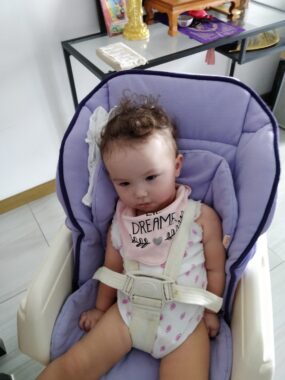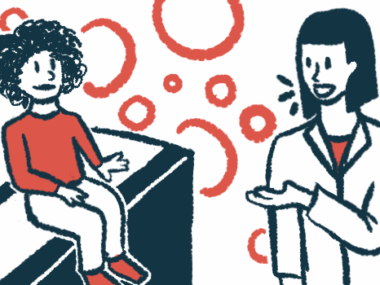There was no road map with AADC deficiency, so we became the guides
Our journey comes full circle with news gene therapy will be covered in Taiwan
Written by |

When our daughter, Rylae-Ann, was diagnosed with aromatic l-amino acid decarboxylase (AADC) deficiency, my wife, Judy, and I felt utterly lost. The diagnosis was ultrarare, the prognosis uncertain, and the treatments limited. There was no road map or guide for this new journey we never imagined we would face.
We were thrust into a world few understood, with no clear process about how to care for our daughter or how to seek treatment. Each doctor’s appointment brought more questions than answers. Yet deep down, we knew we had to keep moving forward for Rylae-Ann. This was not just about survival. It was her only chance at life.
Within the first month of being born in April 2018, Judy and I knew something was wrong. Rylae-Ann struggled to meet even the tiniest milestones. She was floppy, had trouble holding her head, and cried endlessly as if her tiny body was in constant discomfort. No doctor could explain why.
We spent eight exhausting months on a diagnostic odyssey that required us to travel to other countries and hear conflicting opinions — everywhere holding on to slivers of hope. Ironically, it was a random Facebook post from Judy’s brother that helped unlock the mystery. For the first time, we had a name: AADC deficiency.
A future reveals itself

In 2019, before gene therapy, Rylae-Ann sat with support and was unable to move. (Photo by Richard E. Poulin III)
The name gave us clarity, but no comfort. Few treatments existed, and the stories we found online were heartbreaking. Then, in November 2019, Rylae-Ann was enrolled in a clinical trial for gene therapy. We walked into it with a mix of fear and hope. I still remember holding her before the procedure, wondering if we were making the right decision. We didn’t know what the future held, but we believed this was the chance she needed.
Within that first month, we saw what Rylae-Ann’s “reborn day” had made possible. Small, but life-changing differences began to appear. She began to interact with toys, sat independently, and showed a noticeable urge to explore, despite her body not yet having the muscles to do so. For the first time, we weren’t just imagining her future. We could see it unfolding.
As educators by profession, Judy and I leaned on our background and intuition. We realized that while the science of gene therapy could open doors, it was the daily care afterward that would help Rylae-Ann walk through them. Through trial and error, we developed what we came to call the caregiver lifestyle, an approach built on intentional daily care, resilience, and the belief that parents can actively shape their child’s journey before and after treatment. It included structured routines, playful therapy, and a mindset of turning every interaction into an opportunity for growth.
This didn’t just stay within our family. We began sharing it with the AADC deficiency community and the rare disease world at large. We gave speeches, hosted workshops, and organized parent meetups across the globe. From Singapore to Thailand, from the U.S. to Taiwan. We met parents who once felt the same despair we did, and together we built a community where hope replaced isolation. Along the way, we even contributed to a position paper for parahealth professionals, ensuring caregivers’ voices would influence how children were supported.
Coming full circle

In 2025, after gene therapy, Rylae-Ann is an independent and curious girl who loves all that life has to offer. (Photo by Richard E. Poulin III)
We celebrated each milestone not just for Rylae-Ann, but for every child living with AADC deficiency. We rejoiced when gene therapy was approved in Europe, the U.K., and the U.S. On Aug. 21, our journey came full circle when Taiwan’s National Health Insurance Administration announced that gene therapy for AADC deficiency would be covered under the National Health Insurance program.
For a country with one of the highest rates of AADC deficiency, this decision is a breakthrough that will change so many lives. I will never forget the tears in Judy’s eyes when we heard the announcement. A mixture of relief, gratitude, and disbelief that a treatment that once felt experimental is now accessible to so many.
Judy and I are amazed at how far we’ve come. In the beginning, we were two parents lost in the dark. Today, we are guides for families who walk a similar path, offering the reassurance we once longed for. But even with this milestone, we know the work is far from over.
With more families gaining access to treatment, the role of parents becomes more important than ever. Gene therapy can unlock possibilities, but it is the love, persistence, and dedication of parents before and after treatment that will help their children reach their full potential.
Our journey with Rylae-Ann has taught us that hope is not something you stumble upon. It’s something you build, share, and multiply. And now, with more families stepping onto this path, we are determined to ensure no one ever has to feel as lost as we once did.
Note: AADC News is strictly a news and information website about the disease. It does not provide medical advice, diagnosis, or treatment. This content is not intended to be a substitute for professional medical advice, diagnosis, or treatment. Always seek the advice of your physician or other qualified health provider with any questions you may have regarding a medical condition. Never disregard professional medical advice or delay in seeking it because of something you have read on this website. The opinions expressed in this column are not those of AADC News or its parent company, Bionews, and are intended to spark discussion about issues pertaining to aromatic l-amino acid decarboxylase deficiency.






Leave a comment
Fill in the required fields to post. Your email address will not be published.